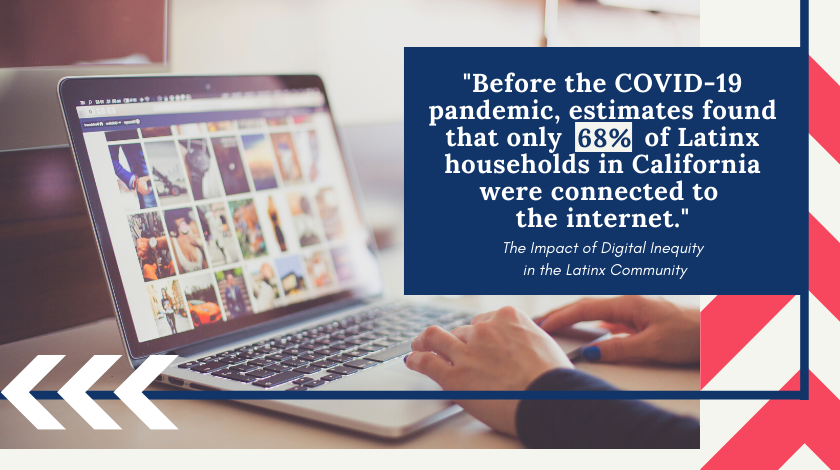By Miguel Leon
For anyone without broadband access, it is difficult to participate in online education, work remotely, utilize telehealth, apply for jobs, and even actively engage in our democracy. Furthermore, the intersectionality of digital inequity makes it a forgotten social determinant of health. For Latinx communities, this was the reality prior to COVID-19 and has been worsened by the pandemic.
Before the COVID-19 pandemic, estimates found that only 68% of Latinx households in California were connected to the internet. The disparity worsened among monolingual Spanish speakers, only 57% of whom could access the internet at home. As it relates to healthcare, researchers found that Latinx people were not only less likely to use the internet to search for health information, but also were less confident in filling out online forms compared to non-Hispanic white populations—both essential practices during a pandemic.
As the pandemic forced students to learn remotely, it was estimated that 13% of college students of color in California lacked internet access, while 12% of college students of color lacked a device to access distance learning. Without internet access and devices, Latinx students risked falling behind.
The Compounding Consequences of Digital Inequity During a Pandemic
Poor communities of color, including Latinx communities, have been battling digital inequity for decades and entered the pandemic facing the following realities:
- Increased risk for serious illness if they contract COVID-19 due to higher rates of underlying health conditions, such as diabetes, asthma, hypertension, and obesity compared to white populations;
- Higher likelihood to be uninsured and to lack a usual source of care, an impediment to accessing COVID-19 testing and treatment services;
- More likely to work in the service industries—such as restaurants, retail, and hospitality —that are particularly at risk for loss of income during the pandemic;
- More likely to live in housing situations, such as multigenerational families or low-income and public housing that make it difficult to social distance or self-isolate; and
- Often working in jobs that are not amenable to teleworking and using public transportation that puts them at risk for exposure to COVID-19.
Ill-equipped to access resources online or work remotely, Latinx individuals have accounted for 45% of COVID-19 deaths in California, despite making up 39% of the population. It is estimated that only 60-70% of Latinx and Black students regularly logged on during remote learning; as a result, the achievement gap that deprives the U.S. economy of $310 billion to $525 billion a year in productivity (equivalent to 2-4% of the GDP) will increase with consequences that will reverberate for generations to come.
Investment in Vulnerable Communities
Federal and state investments in broadband infrastructure open the possibility for innovative approaches to connecting Black and Latinx communities to the internet. Despite progress, vigilance is required as industry is lobbying to maintain its monopoly on what should be a public utility and a human right.
If you’d like to learn more, join the Michelson 20MM Foundation on September 23rd for “Race and Digital Inequity: The Impact on Poor Communities of Color” or visit our website for more information.
Michelson 20MM is a private, nonprofit foundation seeking to accelerate progress towards a more just world through grantmaking, operating programs, and impact investing. Co-chaired and funded by Alya and Gary Michelson, Michelson 20MM is part of the Michelson Philanthropies network of foundations.

